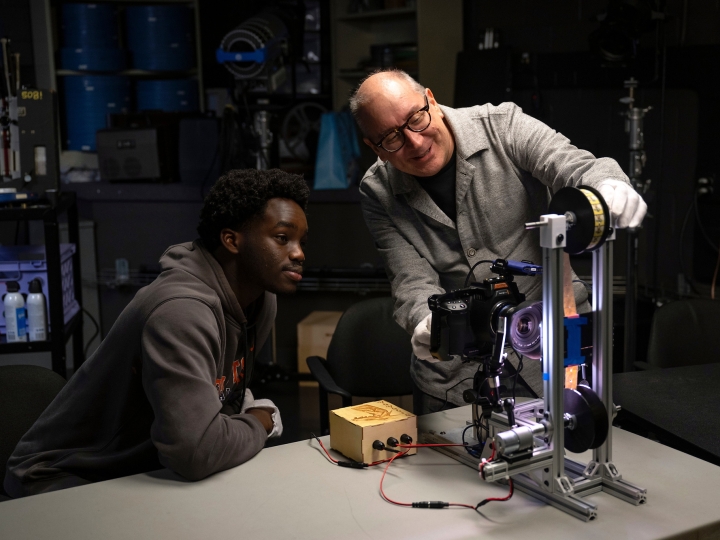Jungle Eyes
December 14, 2015
Professor DeeAnn Reeder, biology, scrolls through the images on her laptop screen one by one. Each shows the same empty woodland grove in western South Sudan, a remote region she has just departed. Ten images flip by, then a hundred, but little catches Reeder's eye. With tens of thousands of photos to come, she quickly clicks forward to the next.
"They were taken by motion-sensitive cameras, so in theory, if there is a photo, something moved," Reeder said. "But lots of time what moved is just grass."
She clicks forward once more, then pauses. One of the creatures Reeder hiked deep into the forest with her cameras in hopes of finding suddenly appears: the African forest elephant. It's the lesser understood of the two distinct varieties of African elephant that were until recently thought to be a single species and much about the forest elephant and its habitat remains unknown. Reeder may have found the first conclusive evidence it inhabits South Sudan. As she clicks again, more elephants fill the screen, juveniles and adults. Reeder is ecstatic.
"When we went to retrieve the images, we didn't see any elephant sign," she said. "No fresh tracks, no fresh dung, nothing. We were really disappointed with that and we thought we didn't get any on our cameras. Then we got back, popped in the SD cards and found we have a ton of pictures of elephants. A number of experts have viewed the photos and agree that these are forest elephants, but we will follow up with DNA analyses."
The images, around 105,000 in all, were collected by 23 motion-sensing cameras set up in January 2015 by Reeder and her research partner, conservationist Adrian Garside of Fauna and Flora International, together with South Sudanese park rangers, as part of a project to document and protect wildlife in South Sudan that is funded in part by a grant from the U.S. Fish and Wildlife Service. The team deployed cameras in the west of South Sudan, a richly forested region where the wildlife of East and Central Africa collide to form a diverse and unique ecosystem and returned in June to swap memory cards and retrieve the images they had captured.
The images were not easy to come by. Unlike much of South Sudan, which was embroiled in civil war at the time of the study, the West has been relatively safe — but its forests are thick and remote. She and Garside, along with a team of wildlife rangers and community "wildlife ambassadors" hiked hours to retrieve the SD card containing the elephant images.
The payoff was worth the effort, Reeder said. While the elephant photos perhaps signify the wildlife survey's most significant find so far, they represent just one of many rare, endangered and just plain skittish creatures captured by the cameras, which also include the African golden cat, the water chevrotain and the notoriously shy bongo.
"A handful of people have predicted some of these species should be in this region, based upon the type of habitat they like, but they've just never been described or documented as being there," Reeder said. "They're all West and Central African species; things that you wouldn't expect if you think of South Sudan as part of East Africa, so we were really so excited. We were glued to our laptops for about three days, once we got out of the reserves."
In all, Reeder and Garside documented at least 36 species of mammals they hadn't been able to find in previous expeditions to the region that used small mammal traps rather than cameras. Among the most significant photos are eastern chimpanzees, the species the U.S. Fish and Wildlife Service gave Reeder her grant to document. In one photo, a chimp appears to have discovered the camera and stares back in a close-up shot Reeder has dubbed a "chimp selfie."
"The fact that we documented chimpanzees is really important given that they're endangered," she said. "It's really necessary to say, 'Yes, they're there. We can study them. We can find their nests. Now, what's the next step that we take toward ensuring conservation of these populations?' "
Conserving and protecting threatened wildlife such as the chimpanzees and elephants Reeder and Garside found is another important component of the project. An important part of the work included training wildlife rangers to monitor and maintain them, as well as community members to go on patrols and document animals they encounter using GPS. Those community patrols offer an extra layer of protection at a time when civil war and an economic crisis have created an uptick in poaching.
"We have wildlife rangers assigned to the game reserves, but they're often not originally from this area," Reeder said. "Partnering with these community members is important because they play a critical role in protecting their own forest."
Bucknell students, too, will have a chance to aid the project.
"We have about 105,000 images," Reeder said. "Adrian [Garside] and I have done a complete pass through them, but we need to look at them again in a more systematic way and Bucknell students are helping me in that work. We're going to find more things in these images."

